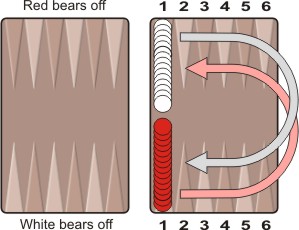![[Backgammon Galore!]](/gif/GaloreButton.gif)
|
|
Backgammon Variants By Robert Reid Descriptions of the The Lombards' Game, also known as El Medio Emperador, date from the thirteenth and fourteenth centuries. It is an early member of a family of games, including Revertier and Swedish Tables, which restrict a player's freedom to pile pieces in the opponent's tables.Setup: Only one half of the backgammon board is used—six points on each side of the board. Each player starts with fifteen checkers on what would be the opponent's six point in regular backgammon. However in Ludus Lumbardorum this is your ace point and the points are numbered in reverse order to the regular board. The checkers move around the board in opposite directions as shown in the diagram below.
Object: The object of the game is to bring all your checkers around to your home table and then bear them off over the bar. The first player to bear off all of his checkers wins the game. To start: Each player rolls one die and the higher number goes first. That player then rolls the dice again to begin his first turn. After the first game, the winner of the previous game goes first. Movement: The roll of the dice indicates how many points, or pips, the player is to move his checkers. The following rules apply:
Hitting: A checker sitting alone on a point is called a blot. If an opposing checker lands on a blot, the blot is hit and placed on the bar. Entering from the bar: Any time you have one or more checkers on the bar, your first obligation is to re-enter those checker(s) into your opponent's home table. You enter a checker by moving it to an open point corresponding to one of the numbers on the rolled dice. If you are able to enter some but not all of your checkers, you must enter as many as you can, then give up the remainder of your turn. Restrictions on closing points: You are not allowed to place more than one checker on points three, four and five in the opponent's home table. However, you may pile as many checkers as you wish on points two and six. Your starting point (point one) also has the same restriction as points three, four and five. Even though you start with more than one checker on this point, you are not allowed to add checkers to it: you can only add a checker to it when it is finally empty. These restrictions make entering checkers more difficult than in regular backgammon because your own checkers create blocks in addition to any closed points created by your opponent. The restrictions only apply to your checkers when they are in your opponent's home table: you are free to pile checkers on any point in your own home table. Bearing off: The rules for this are as in regular backgammon. Gradation of wins: In the original game there were no gradated wins, but you might like to score double for bearing off before your opponent has begun, and/or use a doubling cube. Strategy: It's important to make the two point and six point in your opponent's home table, because these are the ones that facilitate re-entry when the other points are blocked by your own singletons or by your opponent. If your opponent gains control of both of them you will soon be immobilized and your opponent will bring his pieces home easily. Equally if your opponent gains possession of the six point in your home table you will be hampered by not being able to play sixes from your one point. Backgames can result if you can manage to keep control of the two point in your opponent's home table, with checkers still on your starting point. Note: There is nothing in the rules to indicate that you must play the higher number of a throw if you can play one but not both. There is also nothing in the rules to prevent you using the first number of a roll in such a way that the second number cannot be played. Given the tightness of this game you might consider allowing both of these concessions. References
|
![]()
Backgammon Galore : Variants

